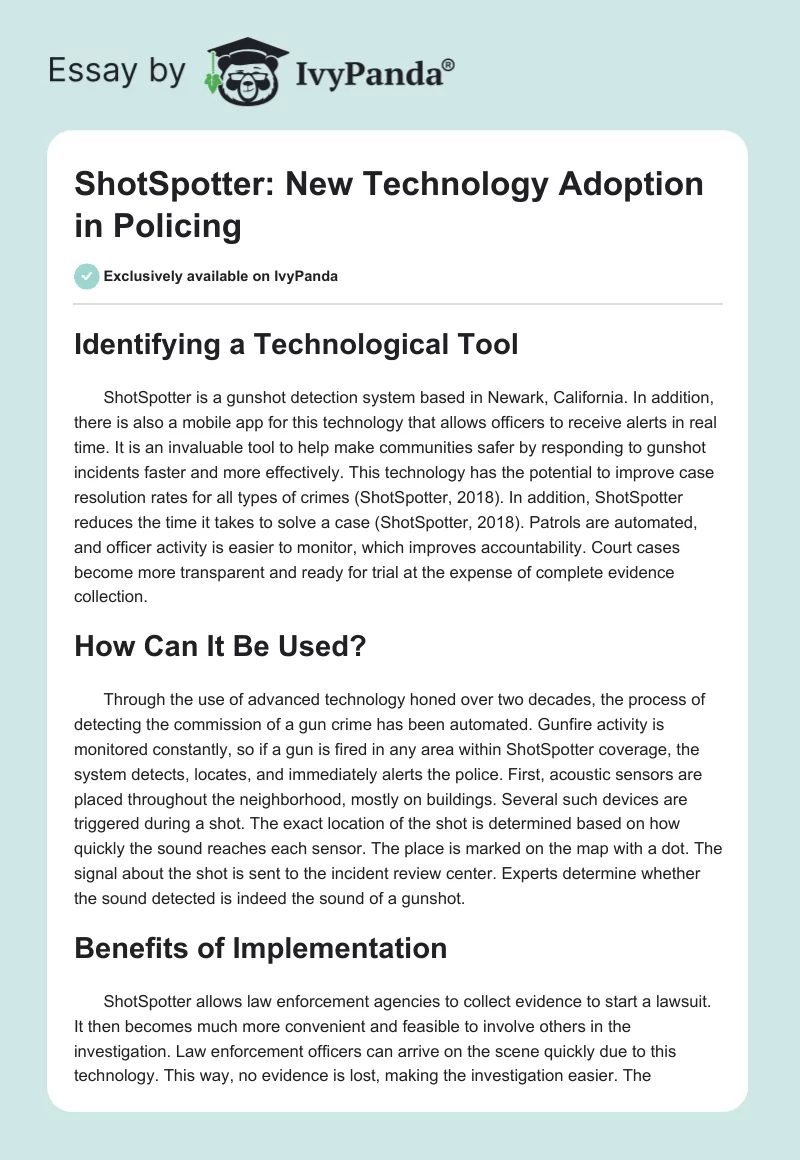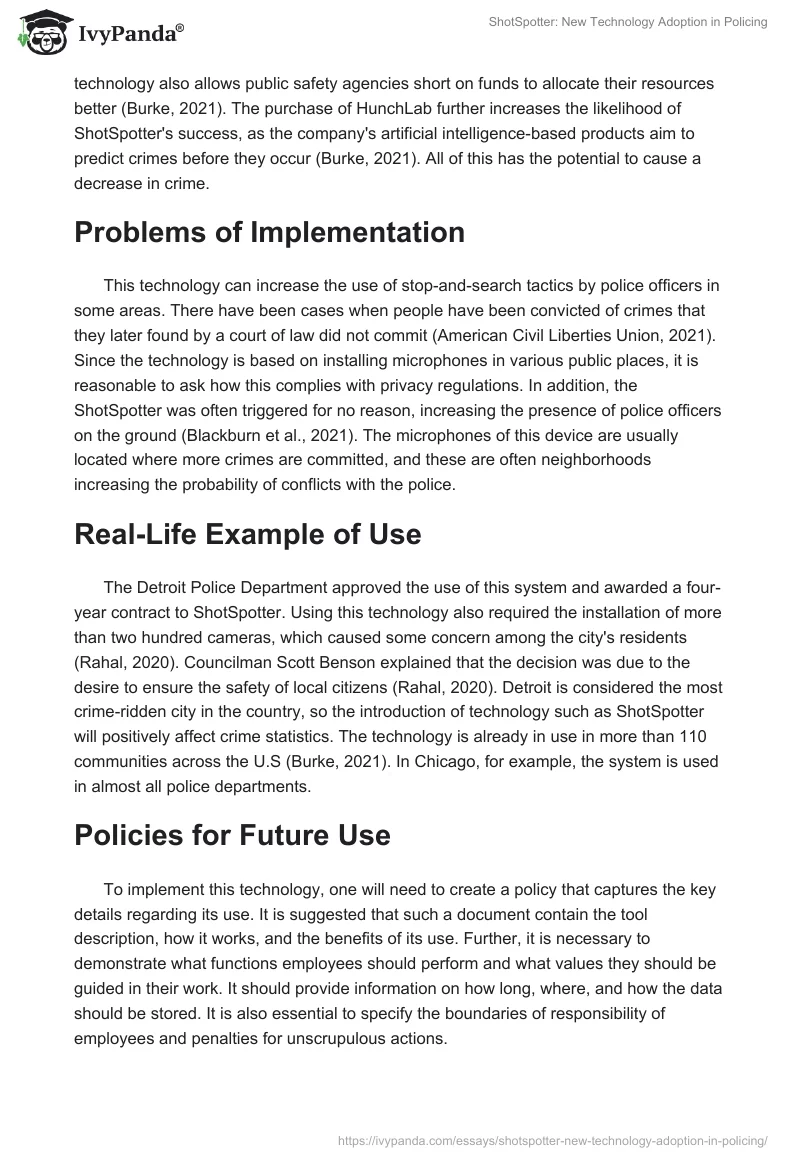Identifying a Technological Tool
ShotSpotter is a gunshot detection system based in Newark, California. In addition, there is also a mobile app for this technology that allows officers to receive alerts in real time. It is an invaluable tool to help make communities safer by responding to gunshot incidents faster and more effectively. This technology has the potential to improve case resolution rates for all types of crimes (ShotSpotter, 2018). In addition, ShotSpotter reduces the time it takes to solve a case (ShotSpotter, 2018). Patrols are automated, and officer activity is easier to monitor, which improves accountability. Court cases become more transparent and ready for trial at the expense of complete evidence collection.
How Can It Be Used?
Through the use of advanced technology honed over two decades, the process of detecting the commission of a gun crime has been automated. Gunfire activity is monitored constantly, so if a gun is fired in any area within ShotSpotter coverage, the system detects, locates, and immediately alerts the police. First, acoustic sensors are placed throughout the neighborhood, mostly on buildings. Several such devices are triggered during a shot. The exact location of the shot is determined based on how quickly the sound reaches each sensor. The place is marked on the map with a dot. The signal about the shot is sent to the incident review center. Experts determine whether the sound detected is indeed the sound of a gunshot.
Benefits of Implementation
ShotSpotter allows law enforcement agencies to collect evidence to start a lawsuit. It then becomes much more convenient and feasible to involve others in the investigation. Law enforcement officers can arrive on the scene quickly due to this technology. This way, no evidence is lost, making the investigation easier. The technology also allows public safety agencies short on funds to allocate their resources better (Burke, 2021). The purchase of HunchLab further increases the likelihood of ShotSpotter’s success, as the company’s artificial intelligence-based products aim to predict crimes before they occur (Burke, 2021). All of this has the potential to cause a decrease in crime.
Problems of Implementation
This technology can increase the use of stop-and-search tactics by police officers in some areas. There have been cases when people have been convicted of crimes that they later found by a court of law did not commit (American Civil Liberties Union, 2021). Since the technology is based on installing microphones in various public places, it is reasonable to ask how this complies with privacy regulations. In addition, the ShotSpotter was often triggered for no reason, increasing the presence of police officers on the ground (Blackburn et al., 2021). The microphones of this device are usually located where more crimes are committed, and these are often neighborhoods increasing the probability of conflicts with the police.
Real-Life Example of Use
The Detroit Police Department approved the use of this system and awarded a four-year contract to ShotSpotter. Using this technology also required the installation of more than two hundred cameras, which caused some concern among the city’s residents (Rahal, 2020). Councilman Scott Benson explained that the decision was due to the desire to ensure the safety of local citizens (Rahal, 2020). Detroit is considered the most crime-ridden city in the country, so the introduction of technology such as ShotSpotter will positively affect crime statistics. The technology is already in use in more than 110 communities across the U.S (Burke, 2021). In Chicago, for example, the system is used in almost all police departments.
Policies for Future Use
To implement this technology, one will need to create a policy that captures the key details regarding its use. It is suggested that such a document contain the tool description, how it works, and the benefits of its use. Further, it is necessary to demonstrate what functions employees should perform and what values they should be guided in their work. It should provide information on how long, where, and how the data should be stored. It is also essential to specify the boundaries of responsibility of employees and penalties for unscrupulous actions.
Similar Policies Used by Other Agencies
The New York government issued an updated version of the ShotSpotter policy in 2021. It fixes earlier mistakes and makes necessary additions to clarify the technology. The document states that the NYPD must balance private and public interests in using this tool (Government of New York City, 2021). There are also provisions aimed at avoiding situations where citizens are subjected to police action on grounds unrelated to the commission of a crime. There are stated administrative and criminal penalties resulting from the misuse of this technology (Government of New York City, 2021). The document specifies what measures to avoid data leaks and protect against unauthorized access. It also determines how long and how exactly the data should be stored.
The Importance of Creating Such a Policy
Law enforcement authorities should set the tone on how to handle technology. That is, establishing fundamental values as well as determining which situations are unacceptable or even punishable is important. In this way, employees will clearly understand their responsibilities and their updated duties. In addition, a training format needs to be defined so that employees have time to familiarize themselves with ShotSpotter. Adherence to departmental policies is key to the effectiveness of the new technology implementation (La Vigne et al., 2019). Therefore, it is extremely important to ensure that all key aspects are outlined. To avoid potential mistakes in the design of such a document, one should be guided by those already created, for instance, the New York policy.
References
American Civil Liberties Union. (2021). Four problems with the ShotSpotter gunshot detection system. Web.
Blackburn, E., & Mares, D. (2018). The hidden costs of police technology: Evaluating acoustic gunshot detection systems. The Police Chief. Web.
Burke, G., Mendoza, M., Linderman, J., & Tarm, M. (2021). How AI-powered tech landed man in jail with scant evidence. Web.
Government of New York City. (2021). ShotSpotter: Inpact and use policy. Web.
La Vigne, N. G., Thompson, P. S., Lawrence, D. S., & Goff, M. (2019). Implementing Gunshot detection technology: Recommendations for law enforcement and municipal partners. Urban Institute. Web.
Rahal, S. (2020). Detroit council approves two controversial surveillance technologies. The Detroit News. Web.
ShotSpotter. (2018). Reduce gun crime with proven gunshot detection technology. Web.


